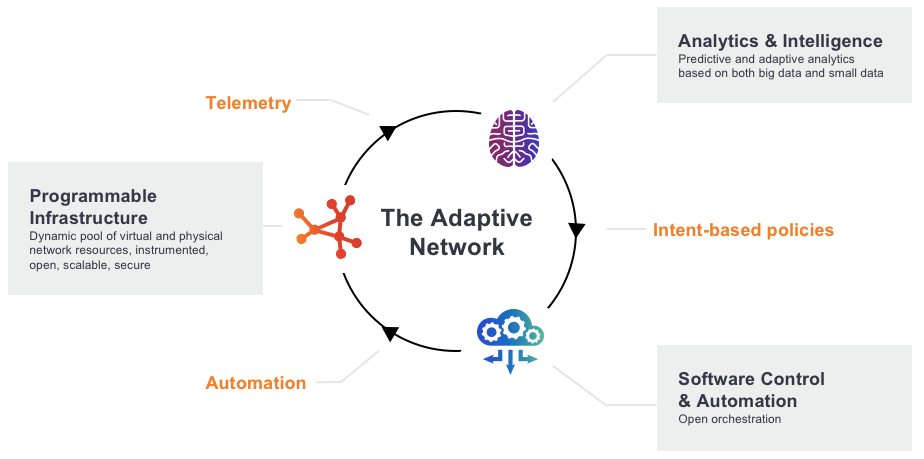A digital India demands an Adaptive Network
India is moving fast towards a digital-first economy that has the opportunity to change the lives of millions of people in India. Furthermore, this digital revolution could provide the opportunity for India to dramatically expand its role and influence in the global economy, and become a powerhouse of digital innovation.
However, developing a true digital economy depends on the speed and reliability of the underlying networks across which information flows. India’s network operators need network architectures that are intelligent, flexible, automated, agile optimized and programmable. These terms aren’t new, but up until now, they were more of a lofty goal then an attainable reality.
Don’t despair. We are on the precipice of a network evolution like no other time in our industry’s history, a collection of technologies and advancements is bringing the long-desired goal of a more automated network closer to reality. These advancements will truly enable network operators and services providers to finally move away from manual processes and multiple network-management systems that require spreadsheets and offline planning tools to make even the simplest changes to the network. I am not talking about “full automation,” or so-called “autonomous networking”. Despite the hype, this isn’t the complete answer network operators and service providers are seeking. You need a solution that will help you adapt to a constantly shifting ecosystem, and automation alone will always have to be revised and reset.
India’s network operators need network architectures that are intelligent, flexible, automated, agile optimized and programmable. These terms aren’t new, but up until now, they were more of a lofty goal then an attainable reality.
It is with this challenge in view that Ciena brings the Adaptive Network to our customers. This Adaptive Network approach enables network operators and service providers to keep pace with growth in capacity, devices and mobility with the right mixture of automation, intelligence, and scale.
For instance, what happens to your network during an IPL final with more than 100,000 people watching it in stadium, sending live updates on Facebook, Twitter or uploading images on social networking sites? Now consider millions are hooked on to their screens on mobile phones/desktops or laptops to cheer their favorite team. When the birth of an overnight sensation can go viral and disrupt the network, how can providers adapt?

Today’s networks are full of legacy systems and protocols, leaving them unable to rapidly scale or adjust. Manual processes are often still required to set up, revise, and tear down even the simplest services. Today’s networks are not designed to adapt to these growing and unpredictable demands.
An Adaptive Network would quickly identify the traffic demand increase based on real-time vs historical analytics, assess the current state of network resources, and engage business policies that drive an automated network response to re-program infrastructure and allocate more resources to high demand areas.
In this case, the Adaptive Network utilizes automation, guided by analytics and intent-based policies, to rapidly scale, self-configure, and self-optimize by constantly assessing network pressures and demands.
Ciena's Adaptive Network leverages 3 key technology advantages:
1. Analytics and Intelligence: Collecting performance data from across the network, and analyzing this data using machine learning, provides the ability to more accurately predict potential network problems and anticipate trends by turning mountains of data into actionable insights. Leveraging these insights can help network providers develop smarter, data-driven business policies that enable them to adapt to customer needs securely, and in real time.
2. Software Control and Automation: Multi-Domain Service Orchestration (MDSO) and centralized, software-defined control of individual domains form the basis of adaptive networking. Through the implementation of SDN, NFV, and open APIs, network providers can simplify the end-to-end management and automation of network services across multi-vendor, hybrid networks.
3. Programmable Infrastructure: A programmable packet and optical infrastructure is one that can be accessed and configured via common open interfaces, is highly instrumented, with the ability to export real-time network performance data, and can adjust its resources as needed to meet the demands of the applications running on top of it.

To be clear, constructing a more adaptive network takes more than the industry finally finding the resolve to do it. There are real technology advancements that must be brought to bear. It is these advancements – nurtured in the care of those with the will and experience to disrupt the status quo – that will drive the industry forward to the reality of the Adaptive Network.
What happens to your network during an IPL final with more than 100,000 people watching it in stadium, sending live updates on Facebook, Twitter or uploading images on social networking sites?
Network operators in India are struggling to gain greater control over an increasingly complex network environment, with vastly increasing numbers of connected users, a broad geographical territory to be served, and the need to manage a variety of network technologies -- be it virtual technologies, cloud services or legacy TDM infrastructure. This all results in varying customer demands in a competitive market that is seeing ever-decreasing average revenue per user (ARPU).
At Ciena we have visualized this complexity. We believe a network must grow smarter, more agile, and more responsive every day to match expectations. We believe network providers must strive to achieve a more adaptive network as they prepare their networks for the torrent of data being unleashed from more and more connected devices, the IoT, and the move of more business-critical applications to the cloud.
Because survival of the fittest means survival of the most adaptive. Let us help your network adapt.





